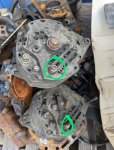LogdeC66
New member
- 6
- 0
- 1
- Location
- Canton, Georgia
Hey guys, I let my M1009 set for around 5 years and have taken to a shop to fix a wiring? Issue and get it running - and sold.
Before i set it to the side, I replaced the alternators, but once the new batteries were hooked up, I had sparks fly once the Negative cable touched.
It’s been so damned long since I replaced the alternators, I seem to recall that once needs to be grounded internally?
The mechanics have both my CUCV (M102 to look at for wiring comparison but have been stumped for over a month.
to look at for wiring comparison but have been stumped for over a month.
How can I test the alternators to see if they are correct - if that is the issue?
Thanks!
Before i set it to the side, I replaced the alternators, but once the new batteries were hooked up, I had sparks fly once the Negative cable touched.
It’s been so damned long since I replaced the alternators, I seem to recall that once needs to be grounded internally?
The mechanics have both my CUCV (M102
How can I test the alternators to see if they are correct - if that is the issue?
Thanks!



